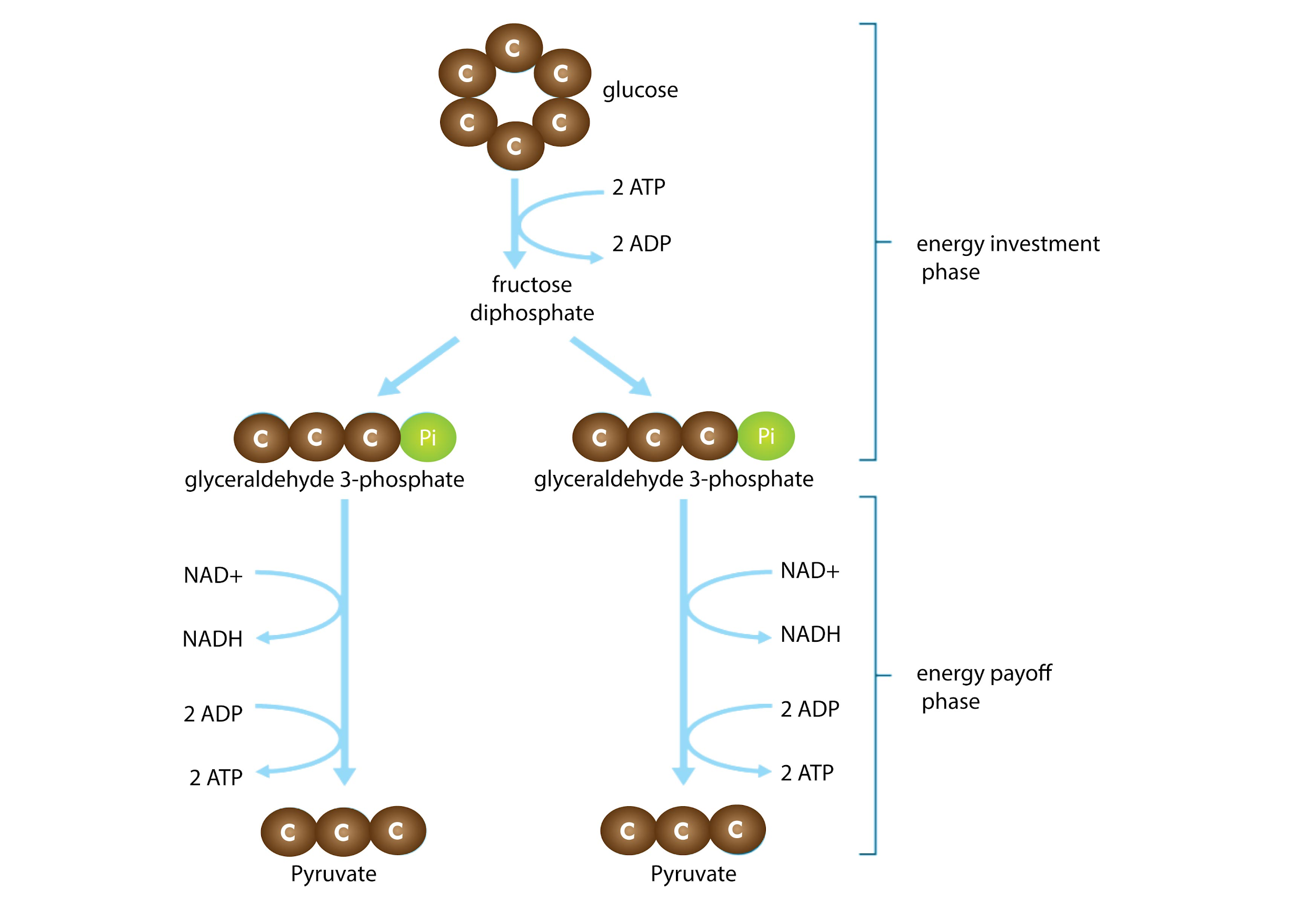
Net gain of ATP in glycolysis
(a) 6
(b) 2
(c) 4
(d) 8
Answer
565.8k+ views
Hint: 4 ATPs are produced and 2NADPH are produced in glycolysis. Each NADPH gives 3 ATP molecules. 2 ATPs are utilized in the glycolysis.
Complete step by step answer:
Glycolysis is the sequence of 10 enzyme-catalyzed reactions that converts glucose into pyruvate with the production of ATP.
2ATPs utilized in the initial steps of glycolysis:
1ATP utilized during the conversion of glucose to glucose- 6-phosphate and 1 ATP utilized during the conversion of fructose-6-phosphate to fructose 1,6 bisphosphate.

During the conversion of 1,3disphosphoglycerate to 3-phosphoglycerate, 2 ATPs released during the conversion of phosphoenolpyruvate to pyruvate 2 ATPs released. In the entire process of glycolysis, 2 NADPH molecules also formed. Each NADH produces 3ATP molecules that mean 6 ATP molecules in glycolysis are produced via NADPH. Therefore the total ATP molecules formed are 10ATP as 2ATPs used up in the initial steps, the net gain is 8 ATP molecules.
So, the correct answer is ‘8’.
Additional information:
Glycolysis is also called the EMP pathway. EMP stands for Embden- Meyerhof- Parnas so it is also called "the Embden-Meyerhof-Parnas" pathway.
It is a unique pathway that occurs both aerobically and anaerobically.
End products of the aerobic pathway and the anaerobic pathways are pyruvate and lactate.
Two substrate-level phosphorylation one is during the conversion of 1,3 bisphosphoglyceric acid to 3- phosphoglyceric acid where 2ATPs are released and second, substrate- level phosphorylation occurs during the conversion of phosphoenolpyruvate to pyruvic acid which gives 2ATPs.
Note: Glycolysis has two phases:
- Phase I: Preparatory phase, Phase II: payoff phase
- 2ATPs consumed in phase I, and 8 ATPs are produced in phase II.
Complete step by step answer:
Glycolysis is the sequence of 10 enzyme-catalyzed reactions that converts glucose into pyruvate with the production of ATP.
2ATPs utilized in the initial steps of glycolysis:
1ATP utilized during the conversion of glucose to glucose- 6-phosphate and 1 ATP utilized during the conversion of fructose-6-phosphate to fructose 1,6 bisphosphate.

During the conversion of 1,3disphosphoglycerate to 3-phosphoglycerate, 2 ATPs released during the conversion of phosphoenolpyruvate to pyruvate 2 ATPs released. In the entire process of glycolysis, 2 NADPH molecules also formed. Each NADH produces 3ATP molecules that mean 6 ATP molecules in glycolysis are produced via NADPH. Therefore the total ATP molecules formed are 10ATP as 2ATPs used up in the initial steps, the net gain is 8 ATP molecules.
So, the correct answer is ‘8’.
Additional information:
Glycolysis is also called the EMP pathway. EMP stands for Embden- Meyerhof- Parnas so it is also called "the Embden-Meyerhof-Parnas" pathway.
It is a unique pathway that occurs both aerobically and anaerobically.
End products of the aerobic pathway and the anaerobic pathways are pyruvate and lactate.
Two substrate-level phosphorylation one is during the conversion of 1,3 bisphosphoglyceric acid to 3- phosphoglyceric acid where 2ATPs are released and second, substrate- level phosphorylation occurs during the conversion of phosphoenolpyruvate to pyruvic acid which gives 2ATPs.
Note: Glycolysis has two phases:
- Phase I: Preparatory phase, Phase II: payoff phase
- 2ATPs consumed in phase I, and 8 ATPs are produced in phase II.
Recently Updated Pages
Master Class 12 Business Studies: Engaging Questions & Answers for Success

Master Class 12 Economics: Engaging Questions & Answers for Success

Master Class 12 English: Engaging Questions & Answers for Success

Master Class 12 Maths: Engaging Questions & Answers for Success

Master Class 12 Social Science: Engaging Questions & Answers for Success

Master Class 12 Chemistry: Engaging Questions & Answers for Success

Trending doubts
What is meant by exothermic and endothermic reactions class 11 chemistry CBSE

Which animal has three hearts class 11 biology CBSE

10 examples of friction in our daily life

One Metric ton is equal to kg A 10000 B 1000 C 100 class 11 physics CBSE

1 Quintal is equal to a 110 kg b 10 kg c 100kg d 1000 class 11 physics CBSE

Difference Between Prokaryotic Cells and Eukaryotic Cells




